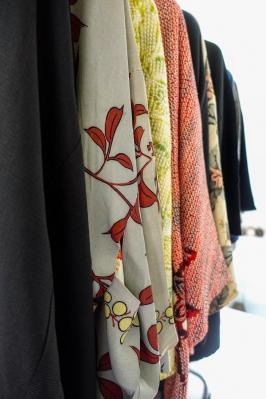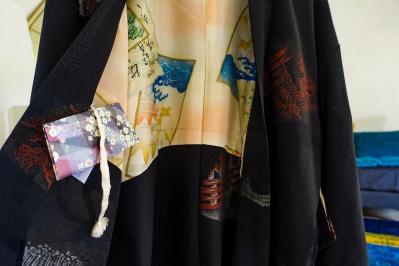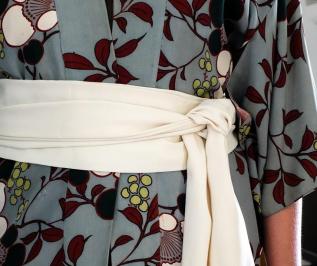Beau & Chic Japonais, traditional Japan wearing according to Françoise Mouton-Perronnet
FR - Françoise Mouton-Perronnet is the witty spirit behind Beau & Chic Japonais, a unique link with Japan and traditional clothing. Haori, yukata and hanten, presented at exhibition-sales such as the one that took place at Emotions sans modération in Montaren, recall a very special way of life.
Follow the UzEssentiel editorial team on its...
Journey to the heart of Japan

Françoise's travels throughout her professional life, between pharmaceutical and cosmetics industries marked the beginning of her oriental adventure. Over thirty years ago, these trips enabled her to gradually familiarise herself with the country, as well as with Korea and China, but also made her fall irrevocably in love with its culture. Acquiring her very first haoris at that time, she continued her quest for unique and exceptional pieces, thanks to the advice of her Japanese collaborator during visits and discoveries of shops and workshops.
Now retired, her personal collection is remarkable. Although she now divides her time between Lyon, Montaren and numerous trips to Japan, she also wanted to demonstrate her deep attachment to Oriental traditions by creating Beau & Chic Japonais two years ago.
|
‘I've always had a passion for Japan, its culture, its gastronomy, its beauty rituals and its clothing history..., I want to share this through Beau & Chic Japonais’.
|

Beau & Chic Japonais, or the art and the way of presenting clothes of high-class, full of charm, delicacy and elegance... And it's sure to win over lovers of the land of the Rising Sun and the uninitiated too.
Beau & Chic Japonais is also about passing on an age-old history, with an incredible emotional charge, told in part by the haori, the traditional jackets worn over kimonos since the distant Edo period (1600/1868).
Françoise's unique silk pieces come straight from the artisanal sewing workshops of Japan, where the making of haoris and other kimonos is governed by a whole series of rigorous techniques.
The oldest pieces are still kept in ‘tansus, old Japanese chests made of fragrant cedar wood’, delicately protected by tissue paper.
Bought and found, all the pieces are vivid images of traditional Japan, an era that is unfortunately tending to disappear over the decades.

|
Did you know? Haori is derived from the verb haoru, meaning to put on a dress, coat or jacket. Once worn by men, jackets have been worn by women since the early 20th century.
‘The first haori jacket I bought in a small shop in the historic Asakusa district of Tokyo, literally transported me to a world of serenity, aesthetics and solemnity. It was a black wedding haori, very sober and transparent, decorated with the family coat of arms - the ‘kamon’.
|

The various pieces, sourced from the best suppliers in Tokyo, Kyoto, Yokohama and Kamakura with the help of a Japanese-speaking friend and the enlightened assistance of a teacher in the art of the kimono, also allow Françoise to perfect her knowledge of the ceremonial that surrounds these garments. Because it's quite an art to know how to put on the haoris or yukata, closed at the side with their draped belt...
Did you know that winter haoris are reversible?
This is an opportunity to take a closer look at the sublime designs that sometimes enhance the lining, revealing a completely different personality brought out by the art of yuzen, the ‘technique of tracing the outline of designs with fine threads of glue made from rice paste’....
Not only coats of arms (the famous kamon), but also fans, a recurring motif, and flowers... It's no longer surprising that the most elaborate garments take between two and six months to make, from pattern to finished garment.
|
‘In Japan, the Yukata is worn daily in public baths (onsen) or as a bathrobe in hotels or ryokan.
|

From haoris to hanten, those quilted winter jackets, a kind of short coat that combines comfort and relaxation, it's just a short step. Françoise can find them in the older districts of Tokyo, as well as yukata, ‘literally bathing garment, a kind of light cotton kimono worn’, whose long, slim cut is perfectly suited to the men who traditionally wore them, as well as to women.
As for the colours, they remain sober most of the time, between deep black, grey or brown. However, some pieces dare to use orange, red or bronze, and sometimes green. The pink of the patterns is reminiscent of the cherry blossom trees, the famous Sakura, so dear to the Japanese, which blossom between Tokyo, Kyoto and the island of Kyushu at the end of April. The rarest colour? Blue, although it would go perfectly with long drapes, which sometimes dare to be transparent.
All in all, what more can we say than that Beau & Chic Japonais plays beautifully a vital role in linking the past and the future, enabling these works of art to keep and retain their place in everyday life and show Japanese craftsmanship to its best.
So, are you ready to enter the Japanese ‘world of serenity’?

Many thanks to Françoise Mouton-Perronnet for her contribution to this article.
The right address: Beau & Chic Japonais. Tel: 06 14 03 60 09. Follow @Beau & Chic Japonais on Instagram.
Photos@saloméwithacamera, red kimono©BeauetChicJaponais.






